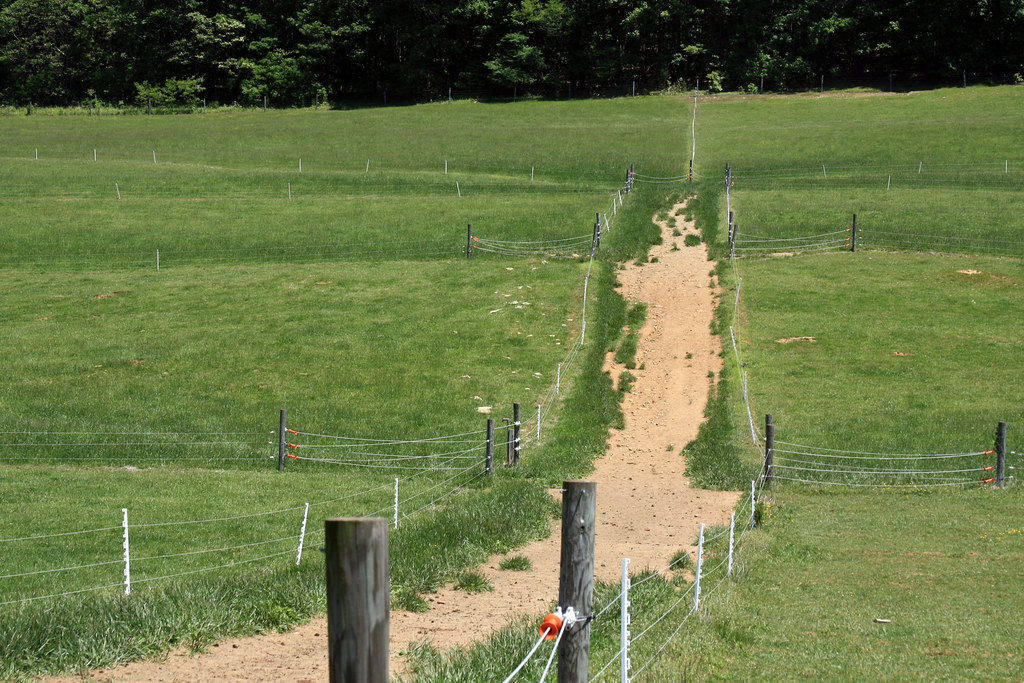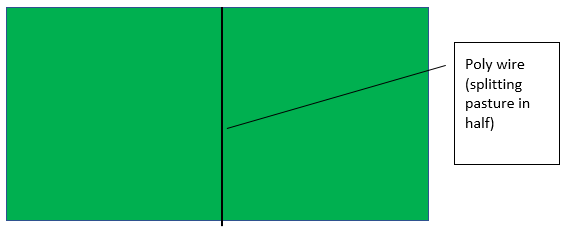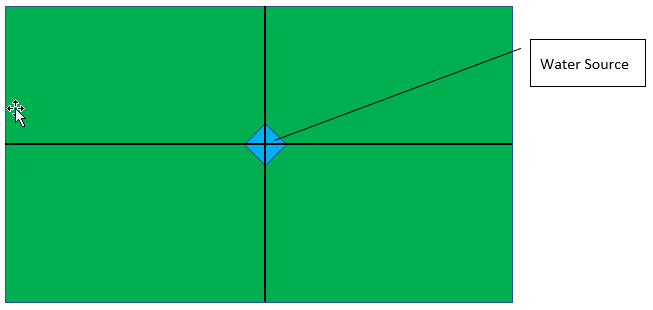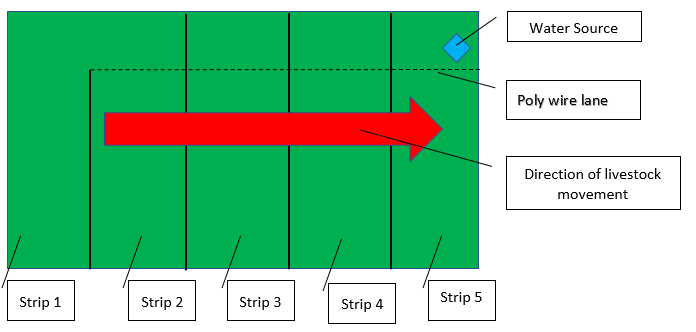Strip Grazing Year-Round
go.ncsu.edu/readext?731713
en Español / em Português
El inglés es el idioma de control de esta página. En la medida en que haya algún conflicto entre la traducción al inglés y la traducción, el inglés prevalece.
Al hacer clic en el enlace de traducción se activa un servicio de traducción gratuito para convertir la página al español. Al igual que con cualquier traducción por Internet, la conversión no es sensible al contexto y puede que no traduzca el texto en su significado original. NC State Extension no garantiza la exactitud del texto traducido. Por favor, tenga en cuenta que algunas aplicaciones y/o servicios pueden no funcionar como se espera cuando se traducen.
Português
Inglês é o idioma de controle desta página. Na medida que haja algum conflito entre o texto original em Inglês e a tradução, o Inglês prevalece.
Ao clicar no link de tradução, um serviço gratuito de tradução será ativado para converter a página para o Português. Como em qualquer tradução pela internet, a conversão não é sensivel ao contexto e pode não ocorrer a tradução para o significado orginal. O serviço de Extensão da Carolina do Norte (NC State Extension) não garante a exatidão do texto traduzido. Por favor, observe que algumas funções ou serviços podem não funcionar como esperado após a tradução.
English
English is the controlling language of this page. To the extent there is any conflict between the English text and the translation, English controls.
Clicking on the translation link activates a free translation service to convert the page to Spanish. As with any Internet translation, the conversion is not context-sensitive and may not translate the text to its original meaning. NC State Extension does not guarantee the accuracy of the translated text. Please note that some applications and/or services may not function as expected when translated.
Collapse ▲ If you saw my previous article on fall pasture management, you read about how stockpiling fescue over the fall can save you from feeding as much hay during the fall and winter months. Also, in that article, I touched on strip grazing or which is also a more intensified version of rotational grazing using temporary fencing materials to help make that stockpiled grass last longer during the grazing season. In this article I am going to go a little further in depth and explain how you can utilize this practice or tool year-round on your livestock operation.
If you saw my previous article on fall pasture management, you read about how stockpiling fescue over the fall can save you from feeding as much hay during the fall and winter months. Also, in that article, I touched on strip grazing or which is also a more intensified version of rotational grazing using temporary fencing materials to help make that stockpiled grass last longer during the grazing season. In this article I am going to go a little further in depth and explain how you can utilize this practice or tool year-round on your livestock operation.
Livestock animals are picky eaters, so to say. To say it in more technical terms, they are selective grazers. Meaning that they will eat what is tasty and skip over what is not tasty. If you have 10 cows grazing on 10 acres or 30 head grazing on 70 acres all year round, you will notice that they are selective grazing. You will see areas where the grass is picked down to the dirt and areas of grass that are knee high as well as a lot of weedy areas. Livestock prefer young tender growing grass. As grass matures, its lignin or fiber content gets higher. This makes the forages not as palatable, therefore they won’t eat it unless they’re forced to. That is where training them to strip graze can help. With strip grazing, you are giving them a “strip” of pasture to eat. When they graze it down to the desired grass height, you give them another strip of pasture. Over time, they should learn that when they get turned into a new strip or paddock, they will not get more grass until they eat what they have already (or at least that is what I like to think they believe!) But honestly, you will notice that when it’s time to move them and they see you, the truck, or 4-wheeler/side by side that you use, they are right next to the fence and excited that they are going to get moved to new grass.
You will need some materials to get started. Most cattle operations already have electric fence, so that’s one thing down. If not, all you need is one strand of wire ran around the perimeter fence that is electrified by either an AC powered box or a solar charged box. From there, depending on the size of your pastures and how intensely you plan to strip graze, I recommend starting out with two fencing reels with a roll of at least 1300 ft of wire on each reel and 50-100 posts. If you already have the electric fence, these materials will cost around $400-$500, depending on quality and brands you choose to buy. Fence reels come in two options, economy/standard ($20-$40) and geared reels ($50-$80). Most geared reels come in 3:1 ratio and in my opinion, they are worth the money and save time and energy in the end. Poly wire price is going to depend on how many conductor wires are in the wire and by how big of a roll you purchase ($30-$55 for ~1300 ft). Step-in posts come in different styles and quality and will run between $2 to $5 each. This sounds like a lot of money to put out at once but, if taken care of, they can last you several years. The reason I listed two reels with poly wire on them, is that it is important to keep the livestock off the areas where they were previously. Like we discussed livestock are selective grazers and will more than likely go back to the area they were once on when it starts to produce regrowth.
Strip grazing can get as intense or as non-intense as you want it to be depending on work schedules, pasture/herd size or time you want to spend moving fence. Some people say that it is too much work and takes a lot of time. It is extra work and it does take time. But when looking at the benefits of forage management and pasture health, I find it is well worth the time and effort. If you want to make it simple to start with, take some wire and posts and split your pasture in half. While the cows are grazing on one side of the pasture, the other side has time to continue to rest and grow. Meanwhile, on the side they are grazing, you have doubled your stocking density by cutting your pasture in half. This makes the cattle closer together than if they have the entire pasture and now, they have to compete with each other more for forage. While this is going on, they are starting to be trained to eat what they have in front of them. Once they have grazed the forage to the desired height (no lower than 3-4 inches), simply turn them to the other half of the pasture. Now, while they are on the other side, the side that they were just on has the opportunity to rest and promote regrowth.

Not only is the stocking density increased, the concentration from nutrients from manure and urine is also increased and spread out more evenly across the section they are on. The tighter and smaller sections that you allow them to have is going to continue to increase the density and nutrient concentration, as well as train them to eat more of the available forages out there. They will just need to be moved to new sections more often. As previously stated, you can make this as intensive as you want it to be. All across the country there are people who move animals to new sections on a weekly basis and some who move them every 30 minutes. The biggest factor in deciding how long they stay on a certain section is how much available forage is out there and how many head is going to be out there. For me, the easiest way to figure that out is by trial and error more or less. If you turn your heifers out on a section that you want to last 3 days and they eat it in 2 days, give them a larger area. On the other hand, if your pregnant cows haven’t eaten the grass up by the time you wanted to move them, tighten them up and give them less area. They key is finding out what works for your own farm and management situation. But one of the biggest things that you need to keep in mind is access to water. At all times, they need to have access to good clean water. Their source of water will be the main factor on how you split up your pastures into paddocks. Here are a few examples drawn out.

For the example above, the source of water is in the middle of the pasture. So, we just split the pasture into 4 paddocks. As time goes along, the livestock will get trained and gain respect for the poly wire. As they gain more respect for it, it will allow you to have more control over them with the poly wire. Fencing out wet areas, disturbed areas, or areas that do not have any grass on them will be easy. You can even build lanes and paths to water sources, barns or working areas or I have even heard of producers loading cows up into trailers just by holding a strand of poly wire up and moving it towards them. For building lanes or adding sections that have corners to them, the standard step in posts can’t handle corners that have a lot of tension pulling on them. For those situations, I like to use fiberglass posts. The come in a variety of diameters but, I’ve found that 7/8” fiberglass posts work the best. One reason I like to add lanes to water is because it allows you to keep the livestock off more of the areas that they have already grazed if your source of water is not placed where they can get water from each paddock or section or if you start giving them small strips of the pasture.
With the example above, we have a water source that is in the corner of this pasture and we have planned to divide this pasture into 5 sections. This doesn’t mean that you need 5 reels with poly wire on them. You can do it with 2. Notice that we have the dotted line set up as the lane to the water source. You can put in a fiberglass post or some other sturdy insulated post and take that reel and make and 90 degree turn and run it to the other side. As they get finished with each strip, keep moving the reel that made the lane and the 90-degree corner closer to the water. Take the second reel and hook at to the fence were the first reel was and hook it to the fence on the other side.
With odd shaped pastures that are not anywhere near a square shape or water sources that are not in easily accessible places, may make rotational and strip grazing a challenge and may require more supplies and head scratching. But, in the end after you get a hang of it, I’m sure you will enjoy it and see the benefits of it.
I have talked a lot about cattle but, it can be done with sheep and goats as well. You can do the same things we have discussed; you will just need to run multiple stands or poly wire or use the poly wire netted fence.
In conclusion, using rotational grazing or more intense grazing practices like strip grazing will help you prevent your pastures from being continuously grazed and will not allow your livestock to be selective grazers. You can train your animals to eat more grass and waste less. Nutrients from animal waste will be more evenly dispersed throughout the pastures/paddocks. One other thing that can happen, especially if your strip grazing in the spring or when your forages are growing, is that after they have strip grazed every section of that pasture, there is a chance that the grass in the first paddock or section has regrown enough to start the grazing over again in the pasture. But, the biggest thing with any rotational grazing practice, is that it will help give those grazed areas time to rest. If forages do not have time to rest and recover from grazing, over time their root system will get depleted and those plants will either die or not be as productive as they could be.




